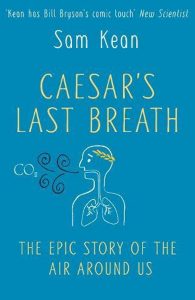Book Reviews
Not Just Air: The Gassy Origins and Basis of Our World and Civilisation
By Vikas Datta | IANS

Title: Caesar’s Last Breath;
Author: Sam Kean;
Publisher: Doubleday/Penguin Random House UK; Pages: 384; Price: Rs 699
There is one thing that unites all us humans, no matter how different we may think we are, or however separated we may be in space and time — at some time or the other, we will breathe in the same molecules exhaled by our immediate neighbour or a stranger across the city, or perhaps even someone in a different continent or century.
“For instance, is it possible that your next breath — this one, right here — might include some of the same air that Julius Caesar exhaled when he died?” asks Sam Kean, an incisive, interdisciplinary, informative — but also most humorous — science populariser. And he goes on to do the necessary math, science and geography to show how possible it is.
And not only Caesar, it could be anyone or anything — from blue whales to bacteria — that breathes, he says.
In his latest book, Kean not only focuses on this aspect but goes far beyond it to craft a unique look at the underlying matter in this phenomenon, to show how its different forms and combinations not only make us but also the universe we inhabit.
As he tells us that the “how-many-molecules-in-X’s-last-breath exercise has become a classic thought experiment in physics and chemistry courses”, but whenever he heard it, he grew restless. “…Why not go further and trace these air molecules to even bigger and wilder phenomenon? Why not tell the full story of all the gases we inhale?”
Kean then goes on to show how every “milestone in Earth’s history you see — from the first Hadean volcanic eruptions to the emergence of complex life — depended critically on the behaviour and evolution of gases”.
It is also gases that not only gave us the air around us but also “reshaped our solid continents and transfigured our liquid oceans”, for the “story of Earth is the story of its gases”.
And he also demonstrates that our lives — especially their length — would be nothing without gases. Leave alone their role in keeping us alive (more than food which we can survive without for weeks and water which we can do without for some days), it was their nature that enabled civilisation to survive, develop and prosper .
For it was understanding their physical power that enabled us make machines that powered industry and transportation and materials that enforce our will in war or reshaping nature. It was exploiting their chemical properties that made possible construction of the edifices of modern civilisation, enabled painless surgeries and helped us grow sufficient food to meet the requirements of a growing population.
His gassy quest, rendered in his witty style, is divided into three parts — dealing with gases in nature, their utilisation by human beings, and the evolution of the relationship in recent times. And with some memorable interludes, Keane takes us through a rollicking ride from the creation of our solar system and our world and its changing atmospheres to the nuclear age and beyond.
But as his account does chronicle some of the greatest scientific discoveries and technological inventions and features all kinds — committed, publicity-hungry, plagiarising, self-testing — of scientists and inventors, it also includes many others too.
Here you also can find charlatans who advanced the cause of surgery, the reformed bootlegger who lived near an active US volcano for five decades and couldn’t be dislodged after warnings of eruption except “in the most spectacular way possible”, the world’s only successful performing “fartomaniac”, the pig who survived a nuclear blast and many others.
A superb and accessible piece of science writing, its biggest lesson is how we owe our existence to random actions of various molecules. And why we should not forget this in the hubris of our achievements.
(Vikas Datta can be contacted at vikas.d@ians.in)

